Beaver, (Castor canadensis carolinensis), are found in streams, swamps, lakes, and bayous with trees nearby in the panhandle and eastward to the Suwannee River. It is dark brown with a gray undercoat and gray tan underside. On the inner toes of the hind feet, there are double claws which are used for grooming. The front sides of the incisors are yellow-orange to deep orange. It is 40-50″ overall with a 15-18″ tail.
Beavers are large (30-60 pound) rodents with webbed hind feet and broad, scaly, flattened tails.
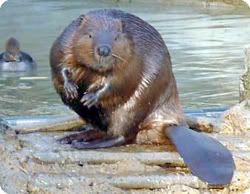 They are nocturnal and feed on the inner bark, twigs, and buds of trees. It will cut down trees with trunks 1-6″ in diameter. Other foods include aquatic plants, cattails, and acorns.
They are nocturnal and feed on the inner bark, twigs, and buds of trees. It will cut down trees with trunks 1-6″ in diameter. Other foods include aquatic plants, cattails, and acorns.
It builds dams from the trees it cuts down, cutting the limbs and branches into manageable pieces and dragging or floating them to the dam. Most beavers don’t build lodges but live in deep dens in stream banks. The entrances are underwater with a tunnel sloping upward to a dry living chamber.
Beavers live in family groupings composed of the mother, father, and two generations of offspring. Mates are often monogamous, breeding in December or January. At about 4 months old, the parents drive the yearlings away. The kits, weighing about a pound each, can swim the day they are born.
Young beavers are preyed on by alligators and large carnivores. Man is the primary predator of adult beavers.
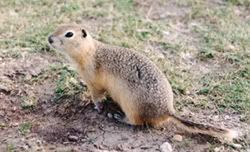 South-eastern Pocket Gopher, (Geomys pinetis), are found in areas of sandy soil from central Florida northward. It is light or reddish brown with a tan or buff underside. Its 3-3.5″ long tail is hairless. It reaches a length of 9-12″ overall. They have large bodies and heads, enlarged front claws, small eyes and ears, and short tails. They have large incisors and cheek pouches. There is only one species in Florida.
South-eastern Pocket Gopher, (Geomys pinetis), are found in areas of sandy soil from central Florida northward. It is light or reddish brown with a tan or buff underside. Its 3-3.5″ long tail is hairless. It reaches a length of 9-12″ overall. They have large bodies and heads, enlarged front claws, small eyes and ears, and short tails. They have large incisors and cheek pouches. There is only one species in Florida.
Also called the “salamander”, it lives underground in a extensive network of tunnels which can be up to 500 feet long. As it digs, it pushes the soil to the surface, creating a row of sand mounds. It eats roots, tubers, especially those of Bahia grass, and bulbs.
It is solitary except during the breeding seasons in February or March and June or July. Litters contain 1-3 young which leave when they are 6 weeks old.
Predators include snakes (pine snakes in particular), weasels, and sometimes owls, hawks, cats, dogs, skunks, and foxes.
Southern Flying Squirrel, (Glaucomys volans), is found in wooded areas state-wide except the Keys. It is buff brown to gray with a white underside, large eyes, and a broad, flat 3.5-5″ tail. It is 8-10″ long. It has a loose fold of skin along each side from wrist to ankle. When it extends its feet, this fold creates a wing-like surface so that the squirrel can glide from tree to tree. The average glide is 30-50 feet.
It nests in tree cavities and nest boxes, including purple martin houses. Nest boxes should be placed 8-10 feet above the ground on tree trunks. It is nocturnal and forages mainly in trees for acorns, pecans, insects, bird eggs and nestlings, berries, fruit, seeds, and buds. It caches nuts and seeds.
It breeds in January or February and again in August or September. After a 40 day gestation, a litter of 1-6 young is born.
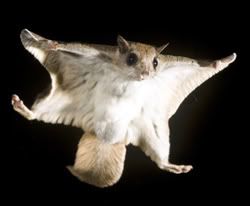
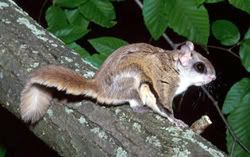
Eastern Gray Squirrel, (Sciurus carolinensis), is found in wooded, suburban, and urban areas state-wide. It is usually light to dark greyish brown with a white or buff underside but may also be all white or blonde with a white underside. It has small, rounded ears. Its long (7.5-9″) tail is flattened and bushy. The tips of the hairs on the tail are white or gray. It is 16-20″ long.
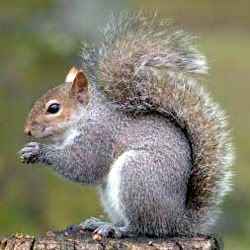
It nests in tree hollows or leaf nests in treetops. It forages during the day, mainly early morning and late afternoon, both on the ground and in trees, living on a diet of acorns, nuts, fruits, berries, insects, and bird eggs.
It breeds in late winter or early spring and again in late spring or summer. The gestation period is about 45 days and litters contain 2-6 young. When the summer litter is due, the female selects a new nest site, leaving the den to the juveniles.
The eastern gray squirrel chatters when disturbed.
Fox Squirrel, (Sciurus niger), is found in pinelands state-wide except for the Keys and perhaps Dade and Broward Counties. It is gray, gray brown, tan, dark brown, or black with an underside ranging from white to black. It has a white forehead and muzzle. It is 23-40″ long including its long (11-13″), bushy tail.
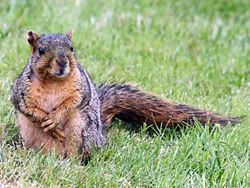
It is active during the daytime, typically foraging midmorning, noon, and late afternoon. It spends most of its time on the ground. Diet includes acorns, nuts, pine and elm seeds, tubers, fruit, berries, insects, bird eggs, buds, and mushrooms. It frequently caches nuts and seeds.
Nests are built in hollow cavities in pine, oak, and cypress trees or leaf nests are built in treetops.
It breeds in late winter or early spring. Older females breed again in summer. A litter of 1-6 is born following a 45 day gestation. The young leave the nest when 3 months old.
It chatters when disturbed.
Eastern Chipmunk, (Tamias striatus), is found in deciduous woods, forest edges, and residential areas with trees in the northwest panhandle. It is reddish brown with five dark stripes alternating with 2 lighter stripes. Its sides and underside are buff to white and its feet are tan. Its tail is dark with a reddish underside. It has cheek pouches and short, rounded ears. It is 8.7-10″ long with a 2.7-4″ tail.
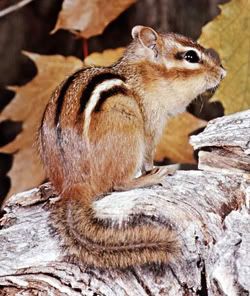
The chipmunk is a ground-dwelling squirrel, solitary, and active during the day. It lives in burrows under trees, banks, and rocks. Burrows usually have 2-3 entrances and a storage chamber for seeds and nuts. Its diet also includes insects and occasionally frogs, salamanders, small mice and snakes, berries, and bird eggs. It also caches food in shallow ground excavations.
It breeds in early spring and summer. After a 30-day gestation, a litter of 2-7 young is born.
When disturbed it vocalizes with a trilling chip.
Predators include cats, dogs, foxes, bobcats, hawks, owls, weasels, and rat snakes.
White-tailed Deer, (Odocoileus virginianus), are found in forest edge habitats state-wide. It is gray to russet brown with a white underside. It is large (55-80″) with large ears, a large tail, and long slender legs. Males have antlers. Antlers are largest on males 6-10 years old. They are shed in late winter or early spring and regrow 6-8 weeks later.
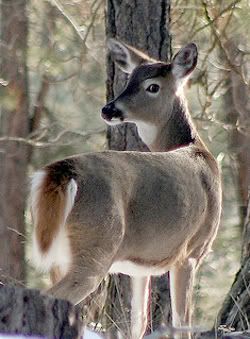
It is a herbivore, feeding primarily on twigs and leaves. Its diet also includes acorns, fruits, and mushrooms. Most browsing is done at night or on overcast days.
Breeding season is from September to March. About 200 days later, a litter of 1-3 fawns is born. The young begin accompanying the mother to feed at 3-4 weeks but are not weaned for another 2-3 months and will remain with her until they are 6-18 months old.
Predators include man, dogs, bobcats, coyotes, bears, and panthers.
Most of the deer in Florida are white-tailed deer. The others are confined to islands.
Key Deer, (Odocoileus virginianus clavium), are found in the Lower Keys, primarily in the National Key Deer Refuge. It is similar in appearance to white-tailed deer, but smaller and with proportionally shorter legs. It also has a black mask on its face.
Breeding season is from September through December. Typically, a single fawn is born.
Feral Pig, (Sus scrofa), was introduced to Florida in the 1500’s and is now found state-wide in wooded areas close to water. Appearance is similar to domestic hogs, but leaner, with a longer, narrower head and a coarser, denser coat. Males have 2-5″ long razor-sharp tusks. It is usually black though may be spotted or mottled. The tusks of females are much smaller. Overall body length is 50-78″ with a 9-13″ tail.
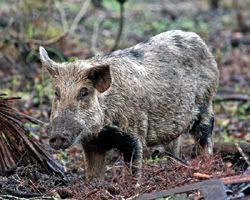
Males tend to be solitary, but several females and their offspring may remain together. Breeding occurs at any time of the year, with litters of 1-12 piglets born about 114 days later. The piglets are weaned in a few weeks but remain with the mother for several months. Females may have two litters per year.
It is an omnivore, foraging on the ground and rooting just beneath the surface, which damages the groundcover. Diet includes acorns and other nuts, mushrooms, fruits, small animals, birds, and carrion. It is rarely active during the day.
Wild boars are also called “razorbacks” because the hair along the backbone stands erect when the boar is agitated. They tend to retreat when approached but can become vicious when cornered.
Natural predators include man, bears, and panthers.

No comments yet.